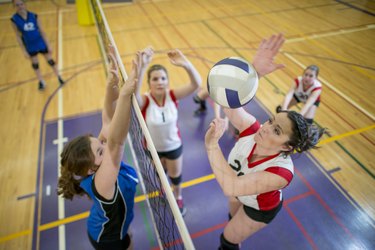
Assessing your vertical jump height can give you an idea of where you rank compared to other student athletes and can clue you in to whether you need to work on your jump height before you try out for a sport.
The vertical jump test directly measures power output by seeing how high you can leap in one explosive movement. Getting started on the vertical jump test at a young age helps aspiring athletes track their progress and monitor their training to ensure their workouts are effective at improving power output.
Video of the Day
Video of the Day
When you can get higher vertically, you have an advantage in a variety of sports. Basketball players may be able to dunk or become a better rebounder. Football receivers have a chance to fly over the defensive back and make a key catch. And a soccer player may be able to get over the top of the defender and header a shot into the goal.
But just how high should you be able to jump? Here's a breakdown of the average vertical jump for teenagers as well as how to increase your vertical jump height.
How to Measure Your Vertical Jump
This test can be administered using a wall, tape measure and chalk. The National Strength and Conditioning Association recommends the following protocol:
- Rub chalk on your fingertips and stand with your dominant shoulder against a wall.
- Reach up as high as possible and touch the wall, leaving a chalk mark.
- Then, without moving, bend your knees and jump up as high as you can. Reach high on the wall with your dominant arm and place a new mark on the wall.
- Measure the distance between the two points in inches to obtain your vertical jump height.
Good vs. Average Vertical Jump Height
Once you measure your vertical jump, you can figure out where you fall on the scale. According to a widely cited 2006 excerpt in Norms for Fitness, Performance and Health, 13- to 14-year-old boys can use the following scale to assess their jump:
- The average, or 50th-percentile, jump is about 17 inches.
- The 10th to 20th percentiles run from 12.3 to 13.8 inches
- The 30th to 40th percentile is 15 to 16 inches.
- Above-average vertical jump score is the 60th to 70th percentile, which ranges from 18 to 19 inches.
- An excellent rating is 20 to 21 inches, which is the 80 to 90th percentile.
For comparison, when Michael Jordan was at the peak of his career with the Chicago Bulls, his vertical jump was measured at 43 inches.
How to Increase Your Vertical Jump
If you're falling into below-average jump ranges or just want to improve your power output, there are exercises and techniques to incorporate into your workout. Vertical jump is largely a function of strength. The stronger your legs, hips and core muscles, the more power you'll be able to generate when you jump.
Strength workouts that include squats, lunges and deadlifts will give you the ability to jump higher. Aim for 3 sets of 8 to 12 repetitions each. According to sports coach Brian Mac, if you're a heavier person, you need to apply more power to achieve the same jump height as a lighter person, because you have a larger mass to move.
Once you've developed strength in your legs, hips and core muscles, developing your jumping skills with plyometric training will help you jump higher. Plyometrics help improve your stretch-shortening cycle, or your muscular and neuromuscular contraction speed, according to conditioning specialist Josh Henkin.
High school athletes can do this by standing to the left of a 15-inch box and jumping over it so you are on the right side. Do 10 back-and-forth jumps and then take a one-minute break before repeating the drill. They can also incorporate box jumps, hops, and bounds using one and both legs.
If you don't have access to a 15-inch box at home, you can do 3 to 5 sets of 10 tuck jumps, where you jump and bring both of your knees up to your chest. This stimulates the same muscles and power you need to do box jumps. Make sure to take a 1- to 2-minute break in between sets.
Tips for High School Jump Training
Those just entering their teen years are more prone to injury than adults because skeletal growth is so rapid that muscular strength may not support the rate of growth. So keep the following tips in mind:
- Always incorporate a proper dynamic warm-up and static cool-down before and after every workout.
- Stay properly hydrated.
- Don't work out similar muscle groups on consecutive days.
- Give yourself at least two full days off a week.
- When lifting weights, always have a coach or trainer present to check your form.
- Never lift heavy weights without a spotter.
- If you experience persistent aches or pains, or are unaccustomed to exercise, talk to your doctor.